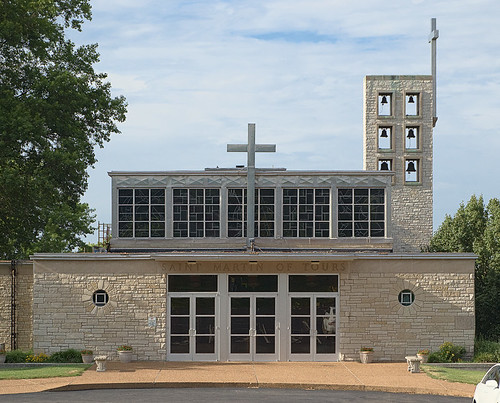
The church appears to be made of native limestone, with aluminum trim: the architectural use of that metal became popular in Art Deco building, and continued with Modernism.
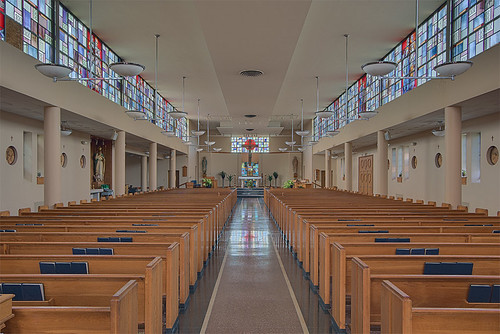
This church has a plan not much different than what is found in neo-Gothic buildings made half a century before, but uses the styling of Modernism. This was typical of the pre-Concilliar period, and this kind of artful High Modernism was quickly abandoned by the mid-1960s in favor of less Catholic designs.
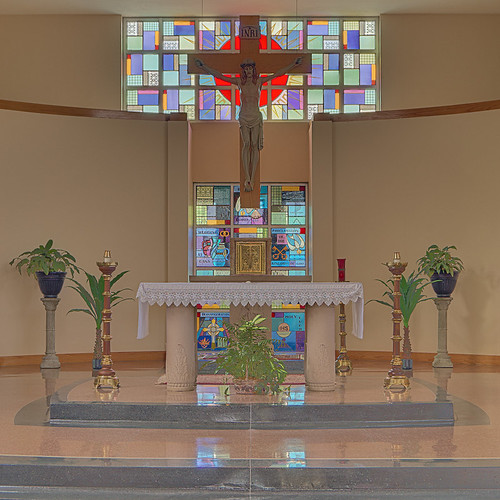
The sanctuary is spartan, yet finely made, as was common during that era. Behind the tabernacle is a new stained glass window which shows the five Luminous Mysteries of the Most Holy Rosary of the Blessed Virgin Mary. The Luminous Mysteries were proclaimed by Pope John Paul II in October of 2002.
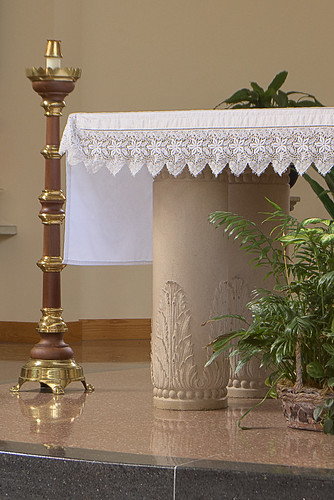
Nice linen covers the altar, which is supported by columns carved with acanthus leaves.

The tabernacle is stone with bronze doors depicting angels in adoration. On the base is the pious pelican, a Christological symbol of sacrificial love. Our Lord waits here in secret; perhaps we could spend some time with Him?
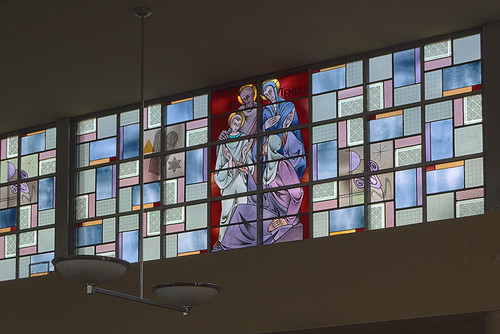
Stained glass windows in the clerestory depict the fifteen traditional mysteries of the Rosary; here is the Finding of the Christ Child in the Temple.

At the musicians' niche, a lyre is depicted in a window.
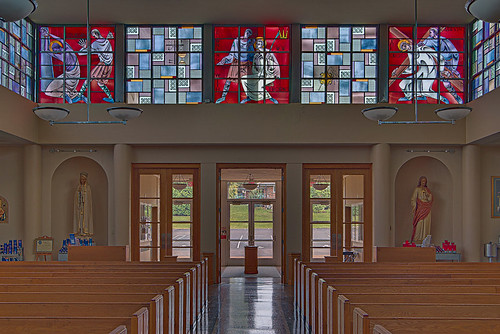
Sorrowful mysteries towards the back.
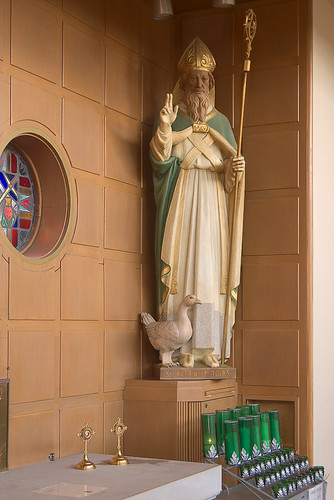
Relics, and a statue of Saint Martin of Tours (ca. 316 - ca. 397). Martin was a Roman soldier, then a holy monk, and then Bishop of Tours in Gaul. According to legend, Saint Martin went into hiding to avoid being made bishop, but a honking goose revealed his location.
Saint Martin has a traditional devotion in France, particularly by men. Whenever France sank into degeneracy and effeminacy — as it is today — renewed devotion to this great Saint led to a great national revival. We ought to remember that Armistice Day, Remembrance Day, or Veterans Day — November 11th — all have their root in Saint Martin's Day. Saint Martin de Tours, priez pour la France!
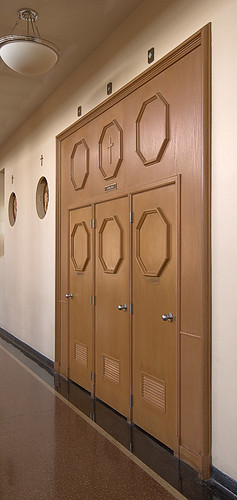
Confessional.

Holy oil.
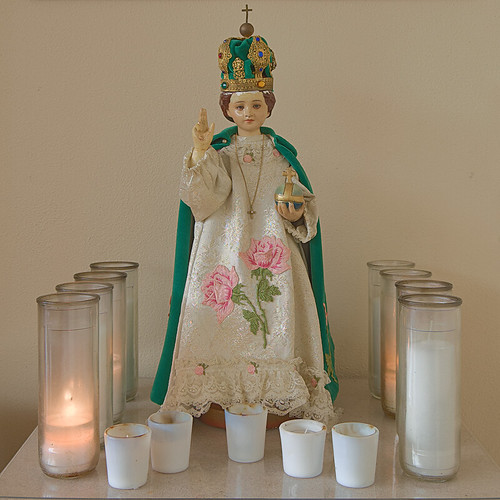
Infant Jesus of Prague.
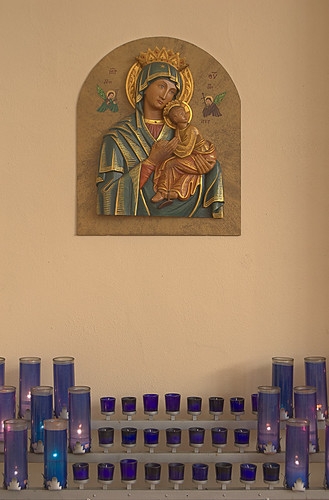
Our Mother of Perpetual Help.
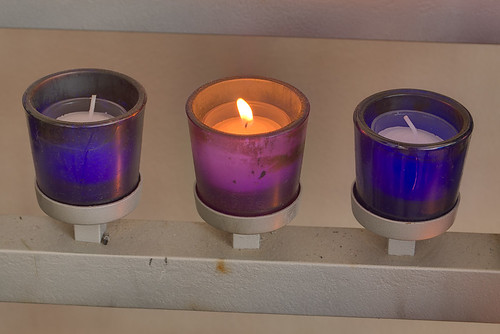
A freshly-lit votive candle.

A prayer when lighting a votive candle.
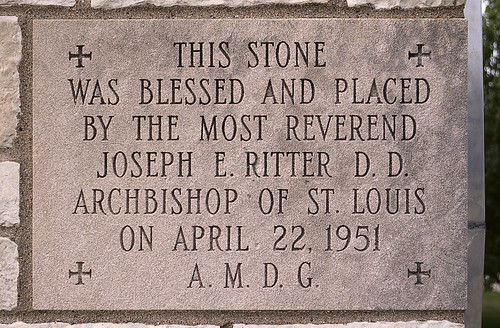
☩ THIS STONE ☩WAS BLESSED AND PLACED
BY THE MOST REVEREND
JOSEPH E. RITTER D.D.
ARCHBISHOP OF ST. LOUIS
ON APRIL 22, 1951☩ A.M.D.G ☩Address:
610 West Ripa Avenue
Saint Louis, Missouri 63125


Now that is a nice, more modern, church. I love the picture of the Oil of the Infirm as well :)
ReplyDeleteHi! I can solve the mystery of the luminous mysteries stained glass for you, as I am a parishioner of St. Martin of Tours parish! The sanctuary of the Church was remodeled in 2000, and at that time, plain frosted glass was installed where you see the luminous mysteries today. It is only in the last year or so that the luminous mysteries stained glass was installed. Our pastor hired artisans to clean and repair the original stained glass, as some of the frames were allowing rain to seep into the interior. They also created the luminous mysteries stained glass in the style of the original! Hope this helps.
ReplyDeleteThanks! I will update the posting!
ReplyDeleteI'm surprised. I actually like this one. The details are really nicely done, actually and your pictures Mr Abeln. I like the bell tower. Does that style have a name? I was almost put off by the large long interior shot as it reminded me of my high school auditorium, basketball floor, and place for staging plays and everything else including the senior prom. But it does seem to go together and the details redeem the larger impression. Keep up the good work.
ReplyDeleteThis reminds me of St Ann Church in the desert town of Ridgecrest, California, which was built in 1960: simple but beautiful, and all the essentials are there.
ReplyDeleteSt. Martin's must've had a communion rail when it was built: does anyone know whether it is preserved in a warehouse or basement somewhere? At least pictures?
ReplyDeleteThere was originally a simple cut stone rail at the sanctuary and a matching rail setting off the choir area. These are mostly gone, although a few pieces of the choir rail remain on the rectory porch. Sadly, the renovation in 1999, which involved reworking the original, very rectilinear steps and footpace to the sanctuary (and the unfortunate misfit nave lighting) resulted in an irregular curve at the steps to the sanctuary that would be hard to fit for a rail. That said, the resulting altar placement is one of the better jobs I've seen in a recent renovation, leaving room to approach the altar from all sides and giving it true architectural prominence.
DeleteThanks for this -- I suppose something else will have to be done; perhaps a bronze rail in the mid-century style to harmonize with the tabernacle. A freestanding altar is what the liturgy anticipates; one ought to be able to "circumdabo" or "compass" the altar and celebrate ad orientem. It looks like the arrangement at St. Martin's permits this.
DeleteI was up at Ascension this past weekend, now used by an Evangelical congregation calling itself Gospel Power. The interior is pretty well preserved, and the modern style marble communion rail is intact. It reminds me very much of St. Martin's. You can see a picture here. Notwithstanding, I think "decommissioned" Catholic churches ought to be demolished rather than giving them over to this fate.